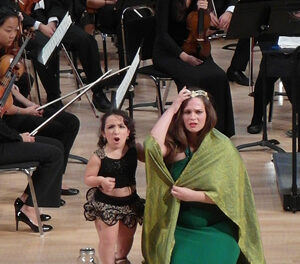One advantage of a music school is that its programming is not driven by the need to fill the hall, so artists are free to explore the fringes of the repertory. Another is the presence of skilled young players whose enthusiasm has not yet been dulled by the marketplace. Both elements were apparent during the Greensboro premiere of Liszt’s Faust Symphony on October 20, when Robert Gutter led the UNC Greensboro Symphony Orchestra, Men’s Chorus, and tenor Robert Bracey, in a vital and dynamic performance of the large work.
There were about 24 violins, a dozen each of violas and cellos, and four stands of double basses. In addition to the usual woodwinds, brass, and percussion, there was an electronic organ, used briefly in the last movement. Risers behind the orchestra were for the large male chorus that sang the final stanza of Goethe’s Faust, Part II , at the end of the last movement.
Liszt’s symphony would have been impossible without the groundbreaking Symphonie fantastique of Berlioz. The two composers met the day before the premiere of the Berlioz work, at which time the French composer introduced Liszt to a French translation of Goethe’s play Faust, Part I . Berlioz dedicated La Damnation de Faust to Liszt, who reciprocated with his own Faust Symphony . Liszt closely identified himself with many facets of Faust’s character. The Faust Symphony is divided into three movements, “Faust,” “Gretchen,” and “Mephistopheles and Final Chorus.” With one exception, noted below, the composer delineates the three principal characters using themes that are modified and juxtaposed throughout the work.
The longest and most complex movement is the first, “Faust,” which uses five themes to depict the many-sided character. A slow introduction uses the first two themes. With exactly matched phrasing, rich and warm violas and cellos opened the work with the first theme, representing the magical and mystical side of the tragic hero. In program notes for the Beecham recording, Humphrey Searle points out that this passage “contains all the twelve notes of the chromatic scale.” In the first of many appearances, the mellow tone of Thomas Pappas’s oboe introduced the second theme. Representing Faust’s full range of emotional character, it is used in a multitude of guises in all three movements. The allegro portion begins the brass section thundering the third theme. Woodwinds announce the fourth theme, leading this stormy section to a tranquil interlude in which Faust’s amorous nature is clearly portrayed. Horn and trumpet calls usher in the fifth theme, a martial phrase played on the trumpets.
In sharp contrast to the tempestuous first movement, woodwinds open the second, “Gretchen,” with a delicate tapestry of chords. The warm and melodious main theme was played with deep feeling by oboist Pappas, accompanied by violist Eric Koontz. The only place in the work where Liszt “sets” a scene from the play instead of sketching the characters themselves is, Searle writes, a short dialog between the clarinet and violins that depicts Gretchen plucking off the “petals of a flower one by one [while] murmuring to herself… ‘He loves me, he loves me not…'”; the solo was tenderly played in Greensboro by Soo Goh. Near the end of the movement, the “pp” appearance of the oboe playing the second Faust theme comes just before the entry of the second Gretchen theme.
Since Mephistopheles “is the spirit of negation,” Liszt uses parodies of the Faust themes in the third movement to portray him. After a complex mixture of all the themes in fascinating pairings with wide-ranging dynamics as well as rhythmic intricacy, the piece ends with the male chorus intoning the “Chorus mysticus” that ends Faust, Part II, with the tenor entering at “Das Ewig-Weiblichte” and then soaring higher as the work comes to its brassy and triumphant close.
The mostly student orchestra played with total commitment and considerable virtuosity. The low strings were outstanding, rich and sonorous. Sometimes the two violin sections showed traces of strain, a hint of sourness or thinness of tone. Liszt frequently calls for a concertino string grouping of two or four musicians to play, and these episodes met the highest standards. All the brass and woodwinds were at their peak form. I loved a recurring fragment in all three movements – a muted pair of horns, seamlessly matched. Mary Pritchett’s handling of the horn solos deserved Gutter’s acknowledgement. The 80-member male chorus, drawn from three university choirs and prepared by Eric Poole, had flawless German diction, and every line was readily understood. Bracey managed the challenging high tessitura well, but I was bothered by strange acoustical effects in the hall that apparently resulted from his being amplified.











